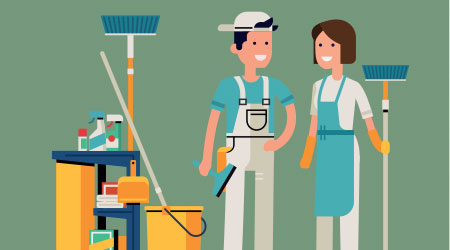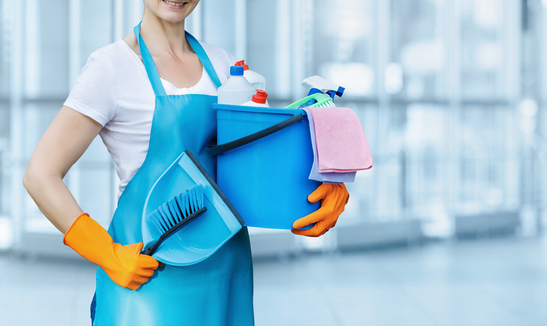Step-by-Step Everyday Cleaning Overview: Specifically How to Scrub the Surfaces, Vacuum Carpets, and Clear Out Any Clutter Effectively
Step-by-Step Everyday Cleaning Overview: Specifically How to Scrub the Surfaces, Vacuum Carpets, and Clear Out Any Clutter Effectively
Blog Article
Recognizing the Need for Thoroughly Disinfecting and Disinfecting Frequently Touched Surface Areas in High-Traffic Locations
In the realm of public health and security, the meticulous sanitation and sanitization of often touched surfaces in high-traffic areas stand as extremely important actions in preventing the spread of harmful virus. The importance of this technique expands far beyond simple cleanliness, delving into the world of condition prevention and neighborhood well-being. By checking out the numerous aspects of surface area disinfection, from the threats associated with neglecting cleansing methods to the effective methods that can be utilized, a more clear understanding emerges of the vital role these practices play in guarding public health. As we navigate this discussion, it ends up being apparent that the ramifications of detailed surface area disinfection resound not only within the boundaries of a specific environment but additionally reverberate on a wider scale, influencing the wellness and safety of individuals across diverse common settings.
Significance of Surface Disinfection
Highlighting the comprehensive disinfection of high-traffic surfaces is vital in maintaining a sanitary environment and preventing the spread of damaging microorganisms. High-touch surfaces such as door takes care of, light switches, lift buttons, and counter tops act as reproducing grounds for viruses and microorganisms. Normal sanitation of these surfaces is necessary to minimize the threat of contamination and transmission of diseases.
By implementing a durable disinfection method, institutions and businesses can create a more secure atmosphere for clients, visitors, and workers. Proper surface area disinfection not only alleviates the spread of transmittable conditions however likewise instills self-confidence in the sanitation and safety of the premises. This proactive approach demonstrates a commitment to health and wellness and wellness, which is especially crucial in high-traffic areas where the probability of direct exposure to microorganisms is increased.
Furthermore, surface sanitation plays a crucial duty in general infection control approaches. Incorporated with hand health practices, using masks, and keeping physical distancing, complete sanitation of high-touch surfaces forms a detailed defense versus the transmission of dangerous bacteria. Prioritizing surface area sanitation is a crucial component of an alternative technique to health and wellness in shared areas.
Dangers of Neglecting Cleansing Practices
Overlooking complete sanitation of high-traffic surface areas dramatically heightens the danger of viral and microbial contamination, presenting a severe danger to the health and wellness of individuals often visiting these rooms. Failing to implement correct cleaning methods can result in the buildup and spread of unsafe microorganisms, consisting of viruses and bacteria, on regularly touched surface areas such as doorknobs, handrails, elevator switches, and counter tops.

Additionally, neglecting the relevance of extensive cleaning not just jeopardizes the well-being of individuals yet likewise threatens initiatives to preserve a clean and sanitary environment. It is essential to identify the relevance of appropriate sanitation procedures in avoiding the spread of infections and protecting public health and wellness.
Reliable Sanitation Approaches
To preserve optimum tidiness and decrease the threat of contamination on high-traffic surface areas, employing reliable sanitation techniques is important. One of one of the most common and reliable sanitation methods is making use of chemical anti-bacterials. These products can vary in toughness and structure, with some targeting particular microorganisms like viruses or microorganisms. It is important to follow the producer's directions for correct dilution, get in touch with time, and air flow when making use of chemical anti-bacterials to guarantee their effectiveness - Scrub the Surfaces.
An additional reliable method is the usage of UV-C light. UV-C light has actually been revealed to be efficient in eliminating a broad range of bacteria by disrupting their DNA structure, hence preventing them from replicating. However, it is important to utilize UV-C light properly, guaranteeing that the appropriate strength and exposure time are related to achieve the wanted sanitation results.
Additionally, employing steam cleansing as a sanitation technique can be extremely effective, specifically on surface areas that are heat-resistant. Heavy steam can pass through permeable surface areas and kill germs, viruses, and other pathogens successfully. When making use of heavy steam cleaning, it is very important to make certain that the surface area reaches the needed temperature level for an enough quantity of time to assure appropriate disinfection.
Effect On Public Wellness
The maintenance of high standards of sanitation and sanitation on high-traffic surfaces plays a crucial role in safeguarding public wellness. Frequently touched surface areas in locations with high tramp, such as doorknobs, handrails, elevator switches, and bathroom centers, offer as reproducing premises for damaging virus.
Reliable sanitation practices not just safeguard individuals from falling unwell however also contribute to the overall wellness of society. Public health and wellness authorities emphasize the importance of maintaining tidy settings to stop break outs and contain the spread of diseases. In high-traffic areas like airports, schools, healthcare facilities, and public transport systems, the influence of strenuous sanitation steps can not be understated. Prioritizing the sanitization of frequently touched surfaces is a proactive technique to promoting public wellness and improving the safety and security of individuals in shared spaces.
Applying Routine Cleaning Up Protocols
Immediately instituting and sticking to a regular timetable of cleansing protocols is paramount for preserving the cleanliness and safety of high-traffic surface areas. Regular cleansing protocols are essential in avoiding the build-up of bacteria and virus on regularly touched surfaces, particularly in areas with high foot traffic. By implementing a systematic approach to cleaning, companies can successfully lower the risk of illness transmission and produce a much healthier environment for employees, clients, and the general public.
To develop an efficient cleaning routine, it is important to determine high-traffic locations that require frequent attention. These areas might include doorknobs, hand rails, lift switches, bathroom centers, and common tools. Executing a regular cleaning routine that targets these surface areas multiple times a day can significantly minimize the spread of dangerous germs and infections.
Furthermore, making use of appropriate cleaner and disinfectants is crucial to making certain that surfaces are thoroughly disinfected. Regular training of cleaning up personnel on correct cleansing methods and the relevance of adherence to the cleansing timetable is additionally important in keeping a sanitary atmosphere. By prioritizing constant cleansing protocols, organizations can promote the health and wellness and wellness of people who connect with these high-traffic surface areas.

Final Thought
In verdict, it is essential to prioritize extensive disinfection and sanitization of often touched surfaces in high-traffic locations to prevent the spread of dangerous microorganisms and maintain public health and wellness. It is vital to identify the value of preserving clean surfaces in high-traffic areas to guarantee the well-being of the community.
In the realm of public health and wellness and security, the careful disinfection and sanitization of regularly touched surface areas in high-traffic areas stand as extremely important actions in protecting against the spread of harmful pathogens. Everyday cleaning By checking out the various elements of surface area sanitation, from the threats connected with ignoring cleansing methods to the reliable techniques that can be used, a clearer understanding arises of the important duty these practices play in safeguarding public health and wellness.In addition, using vapor cleaning as a disinfection approach can be highly effective, particularly on surfaces that are heat-resistant. When making use of vapor cleansing, it is vital to make sure that the surface gets to the required temperature level for an adequate amount of time to assure proper disinfection.
In verdict, it is critical to prioritize extensive sanitation and sanitization of regularly touched surface areas in high-traffic locations to avoid the spread of hazardous pathogens and maintain public health.
Report this page